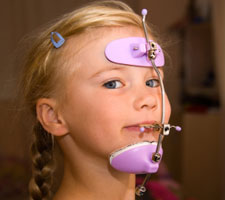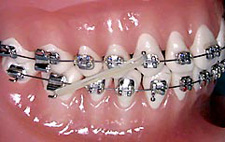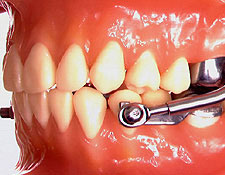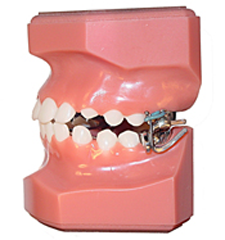Care & Use
Headgear | Retention | Elastics | Herbst Appliance | Rapid Maxillary Expander | Thumb Crib | Separators | MARA
Link to Headgear Headgear
Headgear
Headgear is often used to correct an excessive overbite. This is done by placing pressure against the upper teeth and jaw, which would hold the teeth in position or help move them into better positions. The severity of the problem determines the length of time headgear needs to be worn. The key to success with your headgear appliance is consistency. Headgear can be used during Phase I treatment before braces are applied and during Phase II treatment when braces are in place.
Patients won't need to wear his/her headgear to school or work. Headgear should never be worn while playing sports and should also be removed while eating or brushing your teeth. In order to achieve success in treatment, the headgear must be worn at least 14 hours a day, each day (unless otherwise instructed).
Link to Retention
Retention
While it may vary from patient to patient, the normal period for full-time retainer wear lasts for about two years. During this time, we will schedule regular appointments every 3-6 months to give us an opportunity to monitor your progress and address any questions or concerns you have. After this full period of full-time retainer wear, we will often recommend part-time retainer wear indefinitely, so as to ensure your smile is as straight and beautiful as the day your braces came off!
The forces that our office took advantage of to move your teeth into proper position are the same ones that can shift your teeth into an improper position without care and oversight. Tooth position typically changes in patients over time, regardless of orthodontic treatment, and minor changes to your retainer may be necessary in the future, but our ultimate goal is to keep your smile beautiful and functional for the rest of your life.
Losing or breaking your retainers not only potentially jeopardizes your new smile, it also adds expense for retainer repair or replacement! Therefore, it is important that you treat your retainer with as much care as possible. Brush your retainer with cool (not hot!) water and toothpaste. You may also need to soak it occasionally in dental cleanser to keep it smelling and tasting fresh. And if your retainer is not in your mouth, it should be in its case! Retainers kept in pockets, placed on tables or tucked into napkins are frequently broken or accidentally thrown away. Be sure to keep your retainers away from dogs or other pets, as they will often try to chew on them. If you break or lose your retainer, please contact our office right away so that we can repair or replace it for you as soon as possible.
Remember - retainers are important to keep your new smile forever, so follow through with the hard work you've put in so far!
Link to Elastics
 Elastics
Elastics
Elastics are a vital part of treatment and are also contingent upon patient compliance. They add extra pressure to the braces to help move the teeth. Generally worn at all times (excluding eating and brushing your teeth), elastics should be changed at least once a day. They come in various sizes as they are each used for a specific purpose. We will provide you with the appropriate size.
Your teeth and jaws will likely be tender for the first few days of wearing the elastics, but this should disappear within the week. Please contact us if the discomfort lasts longer than a week. It is important to wear them consistently or treatment setbacks may occur. If only one day is missed, it could cause your teeth to shift back to their original position!
The elastics can be removed when eating your meals or brushing and flossing your teeth. You can leave them in when snacking. After meals, be sure to replace your elastics with new ones immediately. Constant wear of elastics is the key to successful treatment. Part-time wear does not move your teeth.
Be sure to carry extra elastics with you at all times. Replace them often. If you run out, contact us to get more. Don't wait till your next appointment.
Link to Herbst Appliance
 Herbst Appliance
Herbst Appliance
One of the most common problems orthodontists treat is the discrepancy that occurs when the upper teeth protrude beyond the lower. Ordinarily, when we see a patient with the upper teeth protruding, we tend to think that the upper jaw and teeth are too far forward; but, more often than not, this condition is due to a small lower jaw that is further back than it should be. With these patients, we would like to encourage the lower jaw to catch up in growth, and braces like the Herbst appliance help this happen.
Even though the Herbst appliance prevents the lower jaw from moving backward, opening and closing movement still occur easily, and patients do not have any problems learning to chew their food with their lower jaw in this new position.
As with all kinds of braces, patients with Herbst appliances need to be careful about what they eat. For instance, cold foods such as ice slushes, Popsicles and ice will freeze the cement and make the brace loosen. Sticky foods such as caramels, bubble gum and candy suckers will pull the brace away from the teeth. Hard foods like crisp vegetables and hard candies will bend and loosen the Herbst appliance, too. So stay away from these foods during your orthodontic treatment.
Your Herbst appliance will be checked and adjusted at your appointments. If, sometimes between appointments, you develop some sore areas on the inside of your cheeks, please do not try to adjust the appliance yourself. Call for an appointment so that the necessary adjustments can be made.
At first, your mouth will feel unusually full and speaking will be awkward. But if you practice reading aloud, your ordinary speech will return quickly. You may also notice more saliva than normal, but this will decrease as you become accustomed to the appliance.
Link to Herbst Appliance
Rapid Maxillary Expander (RME)
Attached to the upper molars through bonding or by cemented bands, the Rapid Maxillary Expander is an orthodontic device used to create a wider space in the upper jaw. It is typically used when the upper jaw is too narrow for the lower jaw or when the upper teeth are crowded or blocked out of the dental arch.
You will likely experience mild discomfort at the beginning of treatment, but this should subside within a week.
When patients are still growing, their connective tissue between the left and right halves of their upper jaw is very responsive to expansion. By simply activating the expander through turning a screw in the center of the palatal expander, with a special key we provide, gradual outward pressure is placed on the left and right halves of the upper jaw. This pressure causes an increased amount of bone to grow between the right and left halves of the jaw, ultimately resulting in an increased width. Follow the instructions provided to you by Dr. Barrett on how often you should turn the key.
Remember to brush using a Proxabrush and a regular toothbrush. Brush at least three times a day and use a water rinse to flush under the expander.
Link to Thumb Crib
Thumb Crib
To deter the habit of thumb sucking, we offer a simple device called a thumb crib. The thumb crib is made up of semicircular stainless steel wires that fit directly behind the front teeth. They are fastened to the molars to secure the appliance in place. Often times, thumb cribs can stop thumb sucking habits within the first couple of months.
Patients may experience minor discomfort and modified speech for a couple of days. Also, sleep may be disturbed for the first couple of nights.
We will check the Thumb Crib and the patient's thumb or fingers for calluses during each appointment.
Link to Separators
Separators
Separators are small elastics that fit snugly between certain teeth to move them slightly so bands can be placed around them later. Separators can fall out on their own if enough space has already been created. To determine if it needs to be replaced, slip some dental floss between the teeth; if it gets stuck, that means the spacer hasn't created enough room and needs to be replaced prior to your banding appointment.
Link to MARA
 MARA
MARA
The Mandibular Anterior Repositioning Appliance (MARA) is suitable for treating class II malocclusions, which are characterized by protrusion of the upper front teeth or a lower jaw and or teeth that are positioned back in regard to the upper jaw and or teeth. Using MARA, class II malocclusions are treated more effectively. The MARA is reliable and reduces treatment time.
Generally, the appliance is secured to the patient's first molars via stainless steel crowns, which are easy to fit and retain more, compared to bands. The appliance features no removable parts, which means patient compliance is not an issue. Also, the orthodontist can more accurately predict the length of treatment.
The upper "elbows" can be removed; which facilitates comfort and advanced adjustments. The appliance can be advanced on one side or both sides.
Sore spots are minimal. Initially, it may feel strange to hold your jaw forward while eating, but within two weeks, chewing will become more natural. We recommend you eat soft foods initially. Do not chew on the elbows. Avoiding candy, hard foods, etc. throughout treatment will help prevent breakage of the appliance.
MARA is generally worn between 15 to 18 months. Your improvements will be noticed immediately!
